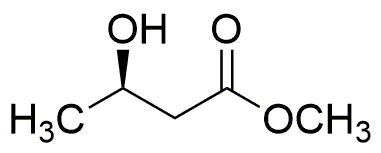Methyl (R)-(-)-3-hydroxybutyrate is widely utilized in research focused on:
- Sports Nutrition: This compound is often used in dietary supplements aimed at enhancing athletic performance and recovery, as it may help reduce muscle fatigue and improve endurance.
- Metabolic Disorders: It plays a role in the management of metabolic conditions, particularly in ketogenic diets, where it can serve as an alternative energy source for individuals with specific metabolic needs.
- Pharmaceutical Development: Researchers explore its potential in drug formulations targeting conditions like obesity and diabetes, given its influence on fat metabolism and energy expenditure.
- Cosmetic Industry: The compound is also being studied for its moisturizing and skin-repairing properties, making it a candidate for inclusion in skincare products.
- Animal Feed Additives: It is used in veterinary applications to promote growth and improve feed efficiency in livestock, contributing to better overall health and productivity.
General Information
Properties
Safety and Regulations
Applications
Methyl (R)-(-)-3-hydroxybutyrate is widely utilized in research focused on:
- Sports Nutrition: This compound is often used in dietary supplements aimed at enhancing athletic performance and recovery, as it may help reduce muscle fatigue and improve endurance.
- Metabolic Disorders: It plays a role in the management of metabolic conditions, particularly in ketogenic diets, where it can serve as an alternative energy source for individuals with specific metabolic needs.
- Pharmaceutical Development: Researchers explore its potential in drug formulations targeting conditions like obesity and diabetes, given its influence on fat metabolism and energy expenditure.
- Cosmetic Industry: The compound is also being studied for its moisturizing and skin-repairing properties, making it a candidate for inclusion in skincare products.
- Animal Feed Additives: It is used in veterinary applications to promote growth and improve feed efficiency in livestock, contributing to better overall health and productivity.
Documents
Safety Data Sheets (SDS)
The SDS provides comprehensive safety information on handling, storage, and disposal of the product.
Product Specification (PS)
The PS provides a comprehensive breakdown of the product’s properties, including chemical composition, physical state, purity, and storage requirements. It also details acceptable quality ranges and the product's intended applications.
Certificates of Analysis (COA)
Search for Certificates of Analysis (COA) by entering the products Lot Number. Lot and Batch Numbers can be found on a product’s label following the words ‘Lot’ or ‘Batch’.
Numéro de catalogue
Numéro de lot/série
Certificates Of Origin (COO)
This COO confirms the country where the product was manufactured, and also details the materials and components used in it and whether it is derived from natural, synthetic, or other specific sources. This certificate may be required for customs, trade, and regulatory compliance.
Numéro de catalogue
Numéro de lot/série
Safety Data Sheets (SDS)
The SDS provides comprehensive safety information on handling, storage, and disposal of the product.
DownloadProduct Specification (PS)
The PS provides a comprehensive breakdown of the product’s properties, including chemical composition, physical state, purity, and storage requirements. It also details acceptable quality ranges and the product's intended applications.
DownloadCertificates of Analysis (COA)
Search for Certificates of Analysis (COA) by entering the products Lot Number. Lot and Batch Numbers can be found on a product’s label following the words ‘Lot’ or ‘Batch’.
Numéro de catalogue
Numéro de lot/série
Certificates Of Origin (COO)
This COO confirms the country where the product was manufactured, and also details the materials and components used in it and whether it is derived from natural, synthetic, or other specific sources. This certificate may be required for customs, trade, and regulatory compliance.

